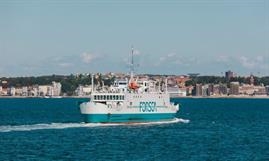
Contract signing at Channel House, P&O Ferries’ Dover HQs © P&O Ferries
P&O Ferries orders world’s largest double-enders for Dover-Calais service
FerryThe Chinese Guangzhou Shipyard International (GSI) sees its order intake for ro-pax ferries further increase following a long-awaited double order from P&O Ferries for a next-generation of Dover-Calais shuttle ferries.
The DP World subsidiary has ordered two vessels, with an option for one plus one. The double order represents an investment of EUR 260 million with delivery slated for 2023 (2024 for the options).
The largest ever to sail between Dover and Calais, the ferries will be of the double-ender type, a first for the 90-minute, 21-nautical-mile route between Dover and Calais. Apparently, P&O Ferries has weighed up the pros and cons of its latest generation, the 2011/2012-built Spirit Class, and concluded that the double-ender concept was more economical and environmentally friendly thanks to a significant reduction in fuel consumption. By virtue of the double-ender concept and the diesel-electric propulsion plant, fuel consumption will be reduced by about one tonne per leg, a sixth of the amount consumed.
The four azimuth thrusters – another first on the English Channel – will enhance the vessels' manoeuvrability. It is understood that the ships will not be scrubber-equipped and the otherwise void spaces below the main vehicle deck will be filled with large battery packs which will be charged by peak shaving, further reducing the ship's fuel consumption. Another reduction in fuel consumption and carbon footprint will come from a heat recovery system, so the total fuel consumption is expected to be reduced by 40%. The ships are futureproofed to become carbon neutral providing extra battery capacity will be installed and plug-in facilities are available in both Dover and Calais.
To achieve the typical tight turnrounds that apply for Dover-Calais ferries, the freight and car intake of the Spirit Class has been retained. The main deck and upper freight deck have a combined capacity of some 2,800 freight lanemetres, whereas about 200 cars can be parked on the separate upper vehicle deck which will have sufficient deck height to stow vans. Like on the Spirit Class, the upper car deck will be accessed via fixed ramps on either side and either end of the vessels. To compensate for the loss in lanemetre capacity caused by the twin bows, the overall length has been increased from 213 metres for the Spirit Class to 230 metres.
Compared to the Spirit Class, the total passenger capacity will be reduced to 1,500 with the lay-out of the accommodation being extremely 'flexible' with up to two-thirds of the passenger facilities that can be closed. A power management system will use innovative software to turn off the lighting and ventilation in empty areas, further optimizing the utilization of engines, batteries and energy recovered from waste heat.
The passenger decks – decks 8 and 9 – will boast double-height windows running around the entirety of the midship, allowing natural daylight to flood in and offering passengers spectacular sea views. There will be plenty of outside deck space too, 1,550m², a departure from the earlier generations.
The ship's concept design has been provided by OSK ShipTech which has close ties with builders GSI through the SinoDane joint venture.
The newbuildings will likely replace the oldest ships in P&O Ferries' Dover fleet: PRIDE OF BURGUNDY, PRIDE OF CANTERBURY and PRIDE OF KENT. As for builders GSI, the EUR 260 million newbuilding contract comes on top of orders from DFDS, Algérie Ferries, COSCO Shipping Ferry Co. and Moby. As Shippax earlier reported, Moby will add at least one more sister to the ones ordered in late June.
© Shippax / Philippe Holthof
Sep 24 2019
Most read
CLdN announces multi-million-pound investment in Killingholme terminal
Mar 31 2025





















